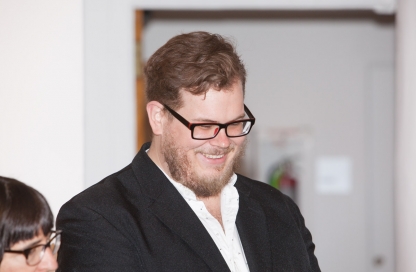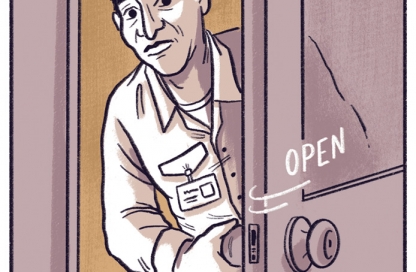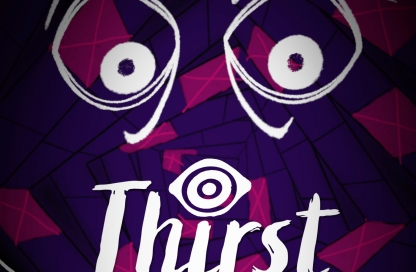Embracing the Mess by MFAVN’s Liz Enright
Last Fall, if asked about how my thesis project was going, my mouth would have landed somewhere between a grimace and a smile. The thesis committee had given my pitch the green light and I was suddenly responsible for creating a graphic novel. At around 100 pages it was no “Don Quixote,” but it was my first long-form comic…and I really, really didn’t want to screw it up. That was my first mistake. The fear of failure made me wary of change. Through multiple, extremely painful rounds of revisions I’ve learned that making mistakes is not only unavoidable (UGH), it has the potential to shape my work in surprising ways.
It all started with an idea, or more specifically, “the movie inside my head.” I begin writing a comic by mentally hitting pause on the most memorable frames before scrawling them in my sketchbook. Of course the movie is entirely impressionistic and the images vague. At the earliest stages of my writing process there are sizable plot holes. Naturally, as the story evolves scenes are cut, added, and combined. It’s no coincidence that the better I know my characters the stronger those images become. A deeper knowledge of story invites specificity. While brainstorming “The Sprout” I understood very little about the fictional world of Squallyglen, as the notes to self on the image below clearly illustrate.

“Need to finalize design,” translates to “Eh, I’ll figure it out later.” The scene above becomes a major turning point in the story, but it’s not quite there yet. It needs context!

Don’t judge the stick figures! My first pass at thumbnails is crude. I’m mostly concerned with getting the entire story down on paper within a set page limit. The page design, panel compositions, and overall pacing are addressed in future drafts.

Sometimes progress is slow and steady… and soul-crushing. I didn’t make much headway with draft two. To my chagrin, it’s only a slightly better drawn version of the first. I’ll give it brownie points for having straight lines, but what good are neat boxes if what’s inside them is useless? The melodrama is only meant to convey that by this point I was feeling hopelessly stuck. Every attempt at editing made the story longer, not better.
Have you ever experienced a terminal amount of creative block at the worst imaginable time? Stop, find an artist you trust, and ask for their feedback. My mentor and thesis class were able to spot things I couldn’t. In the wise words of Tim Gunn, I was stuck in the monkey house . I had labored on the project for so long that I could no longer tell when my ideas stunk.

My peers were able to pick out things like awkward story beats. Sometimes the solution is as simple as condensing pages. In the example above I moved the first panel from page two to the bottom of page one. After a minor reconfiguration the scene becomes cohesive and the final panel gains significance! It seemed fitting to let it extend to the bleed (or edge of the paper) to reinforce its importance.
By draft 4 I was running out of time. Most pages required more than a snip and a paste. Drastic measures were in order, so I tore the book asunder and slid panels from page-to-page searching for the right fit. It was one big narrative puzzle. The exercise helped me see the project with fresh eyes. Finally, the story began to congeal.

Laboring over the same story for hours and hours can be mentally draining. While taking breaks I found it helpful to develop my visual vocabulary. By draft 4 that mountain I intended to design in the early stages of my process was still unresolved. Fortunately, I’d done some rock formation studies in my sketchbook that would come to inform the final design.

Even in the final stages, nothing is set in stone. You’ll notice this page deviates from the fourth draft of thumbnails quite a bit. At a certain point, my thumbnails became more of a suggestion than a law set in stone. I allowed my characters to dictate their actions and reactions to the world around them. The environment developed in response to what those characters needed. For instance, I established scale here to pit two tiny gnomes against a large, frightening world. The page isn’t at all what I first imagined it would be, and that’s not such a bad thing.
The struggle to develop my first graphic novel is ongoing, but so far my biggest takeaway is this: Be receptive to change. Allow yourself to be surprised. Embrace the mess.


